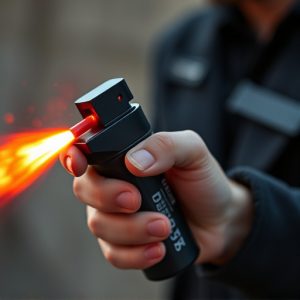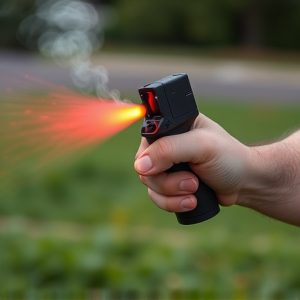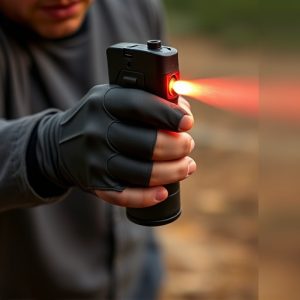Optimizing Pepper Spray Equipment for Enhanced Law Enforcement Tactics
Pepper spray, a non-lethal law enforcement tool, has a defined range of 3-10 meters, with effectiven…….
Pepper spray, a non-lethal law enforcement tool, has a defined range of 3-10 meters, with effectiveness influenced by OC concentration, weather, wind, target's physical state, clothing, and protective gear. In close-quarters confrontations, it temporarily incapacitates suspects through capsaicin, causing eye irritation, coughing, and breathing difficulties. Factors like canister size, valve mechanism, and environmental conditions affect spray range and potency. Law enforcement should select pepper spray based on both range and effectiveness, ensuring reliable disruption of vision, breathing, and movement for safe threat neutralization.
“In the realm of law enforcement, understanding and utilizing pepper spray equipment is a critical component of crowd control and self-defense strategies. This article delves into the intricacies of pepper spray, offering a comprehensive guide for officers on the front lines. From the science behind its effectiveness to the practical considerations impacting range and potency, we explore how the right equipment can enhance safety and operations. Additionally, we provide insights into selecting the optimal pepper spray gear, ensuring officers are equipped to handle various scenarios with precision and control.”
- Understanding Pepper Spray: A Basic Overview
- The Role of Pepper Spray in Law Enforcement
- Factors Affecting Pepper Spray Range and Effectiveness
- Choosing the Right Pepper Spray Equipment for Law Enforcement
Understanding Pepper Spray: A Basic Overview
Pepper spray, officially known as oleoresin capsicum (OC) spray, is a non-lethal chemical agent designed to incapacitate and disrupt an individual’s ability to fight or flee. It works by irritating the eyes, nose, throat, and skin, leading to temporary blindness, coughing, and difficulty breathing. The effects typically subside after a few minutes, allowing for the affected person to recover quickly with minimal long-term damage.
The pepper spray range varies significantly, with typical models offering a range between 3 to 10 meters. Factors influencing this include the concentration of OC in the spray, weather conditions, and wind direction. The effectiveness of pepper spray is not just about its range; it’s also determined by factors like the target’s physical condition, clothing, and any protective gear they might be wearing. Understanding these variables helps law enforcement strategize and respond appropriately to diverse situations.
The Role of Pepper Spray in Law Enforcement
Pepper spray has become an integral part of law enforcement tools, offering a non-lethal option for officers to control and de-escalate potentially dangerous situations. Its primary role is to temporarily incapacitate individuals, providing critical time for police to gain control, ensure officer safety, and manage the incident effectively. The power of pepper spray lies in its ability to disrupt normal respiratory functions when deployed within a specific range.
With a typical pepper spray range varying from 2 to 4 meters (6.5 to 13 feet), officers can strategically use it to create distance from suspects while maintaining control. This non-lethal force option is particularly useful in close-quarters confrontations, allowing police to subdue and capture individuals without causing permanent harm. The effectiveness of pepper spray is well-documented, with its active ingredient, capsaicin, stimulating sensory nerves and leading to temporary blindness, coughing, and difficulty breathing.
Factors Affecting Pepper Spray Range and Effectiveness
Choosing the Right Pepper Spray Equipment for Law Enforcement
When selecting pepper spray equipment, law enforcement agencies must consider various factors to ensure optimal effectiveness during operations. The chosen spray should have a suitable pepper spray range that allows officers to maintain distance while neutralizing threats. Range can vary between products, with some offering a more potent spray for close-quarters combat and others designed for longer-range control.
Additionally, assessing the effectiveness of different types is crucial. Pepper spray’s active ingredient, capsaicin, disrupts vision, breathing, and movement. Agencies should look for sprays with consistent formulation and quality control to guarantee a reliable irritant effect. Testing and reviews from peer agencies can provide valuable insights into the performance of specific brands and models, helping law enforcement make an informed decision that suits their unique operational needs.
Pepper spray has become an indispensable tool for law enforcement, offering a swift and effective means of subduing individuals in diverse scenarios. Understanding its range and effectiveness is crucial for optimal deployment. By considering factors such as distance, weather conditions, and subject dynamics, officers can maximize the impact of their pepper spray equipment. Choosing the right gear ensures that this powerful tool serves its purpose while minimizing risks and ensuring public safety.


